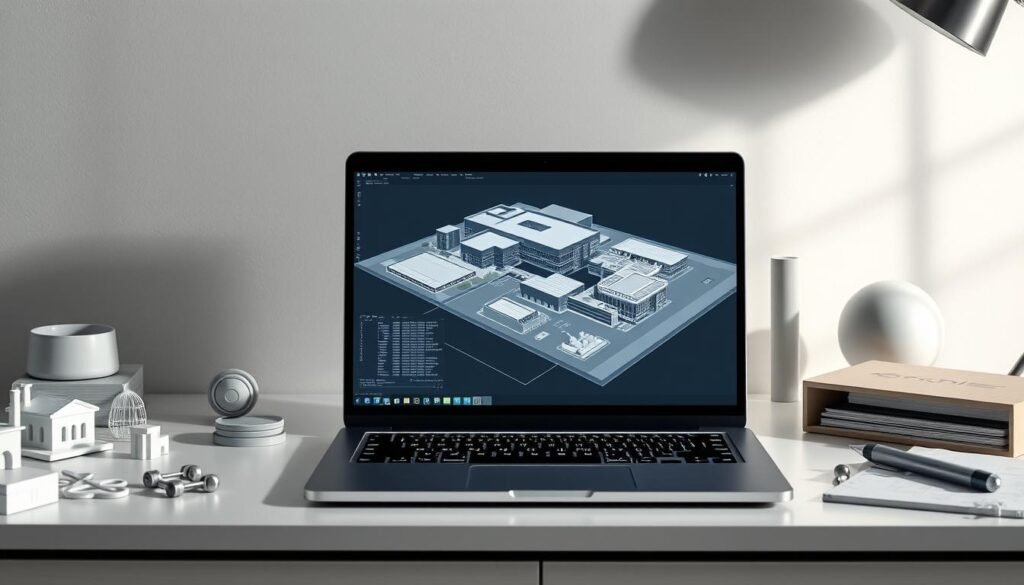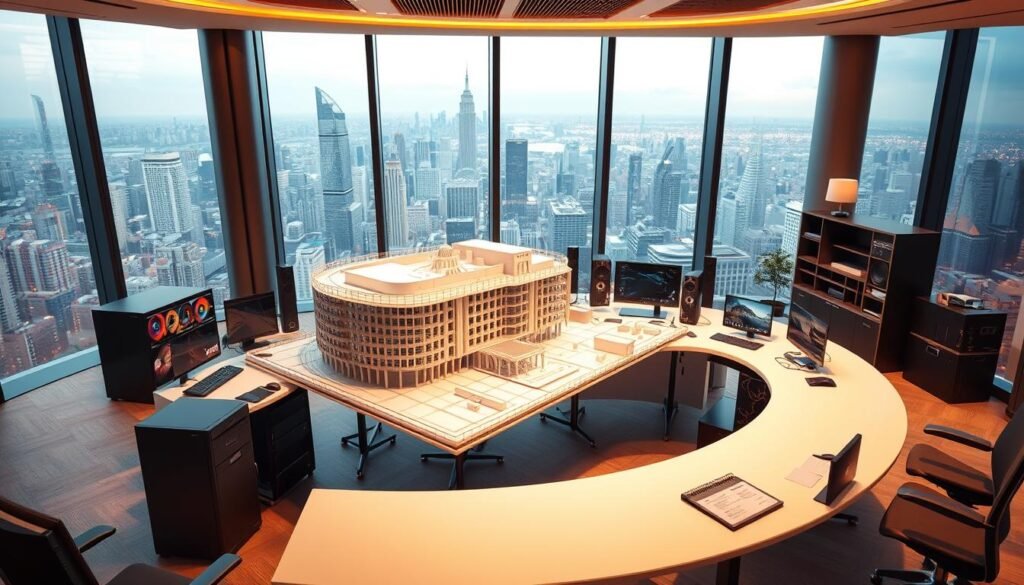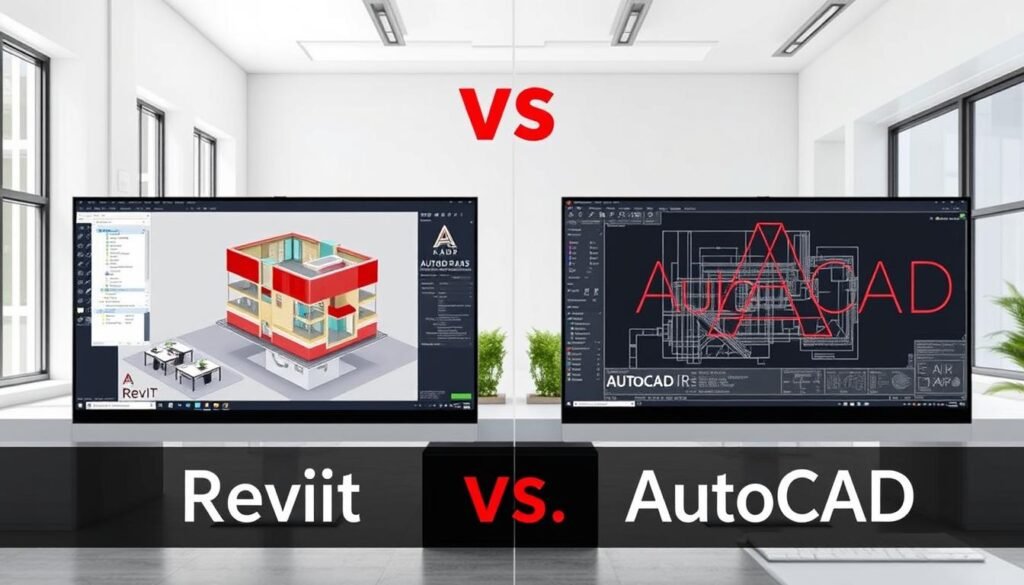As Revit and BIM software continue to revolutionize the Architecture, Engineering, and Construction (AEC) industry, professionals require powerful tools to handle complex projects efficiently. A suitable laptop is crucial for running these demanding applications smoothly.
The right laptop can significantly enhance productivity and performance when working with Revit and BIM. Key factors such as processor speed, RAM, graphics card, and storage capacity must be considered to ensure seamless execution of these resource-intensive programs.
In 2025, AEC professionals need laptops that can handle the latest versions of Revit and BIM software, providing a robust platform for their work.
Key Takeaways
- Processor speed is crucial for running Revit and BIM software efficiently.
- A minimum of 16 GB RAM is recommended for smooth performance.
- A dedicated graphics card is essential for handling complex graphics.
- Storage capacity should be sufficient to store large project files.
- A high-resolution display enhances the overall user experience.
Understanding Revit and BIM Software Demands
To harness the full potential of Revit and BIM, it’s crucial to comprehend their resource-intensive nature and the hardware required to support them. Revit and BIM software are complex applications that demand significant computational resources to operate efficiently.
What Makes Revit and BIM Software Resource-Intensive
Revit and BIM software require powerful processing, advanced graphics handling, and substantial memory to manage complex designs and large datasets. “The more complex the design, the more demanding the software becomes,” as noted by industry experts. This complexity is due to the software’s ability to handle detailed building information models, simulations, and analyses.

The Importance of Proper Hardware for Efficient Workflow
Investing in high-performance laptops for Revit is essential for maintaining an efficient workflow. Proper hardware ensures that AEC professionals can work on complex projects without significant slowdowns, thereby improving productivity. A powerful laptop for Autodesk Revit should be equipped with a robust processor, dedicated graphics card, and ample RAM to handle demanding tasks.
By understanding the demands of Revit and BIM software, professionals can make informed decisions when selecting hardware, ultimately enhancing their workflow and productivity.
Revit System Requirements for 2025
To harness the full potential of Revit 2025, it’s essential to comprehend the official system requirements and how they impact your workflow. Autodesk Revit 2025 brings new features and enhancements that necessitate a closer look at the system requirements for optimal performance.
Official Autodesk Revit 2025 System Requirements
Autodesk has outlined specific system requirements for Revit 2025 to ensure a seamless user experience. According to Autodesk’s official documentation, the minimum system requirements include a 64-bit processor, 8 GB of RAM, and a compatible graphics card. However, for optimal performance, Autodesk recommends more robust specifications.
Key System Requirements:
- 64-bit processor with multiple cores
- 8 GB of RAM (16 GB or more recommended)
- Compatible graphics card with 4 GB of VRAM (NVIDIA Quadro or AMD Radeon Pro)
- 1920 x 1080 or higher display resolution
- Microsoft Windows 10 or 11 (64-bit)

Minimum vs. Recommended Specifications
Understanding the difference between the minimum and recommended system requirements is crucial for AEC professionals. While the minimum requirements allow Revit 2025 to run, the recommended specifications ensure that the software performs optimally, especially with complex projects.
| Component | Minimum Requirements | Recommended Specifications |
|---|---|---|
| RAM | 8 GB | 16 GB or more |
| Processor | 64-bit, multi-core | High-performance, multi-core (e.g., Intel Core i9 or AMD Ryzen 9) |
| Graphics Card | Compatible with 4 GB VRAM | NVIDIA Quadro or AMD Radeon Pro with 8 GB VRAM or more |
Future-Proofing Your Investment
When selecting a laptop for Revit 2025, it’s not just about meeting the current system requirements; it’s about future-proofing your investment. As BIM software continues to evolve, the demands on hardware will increase. Investing in a laptop that exceeds the current recommended specifications can extend its useful life.
“The best way to predict the future is to invest in hardware that can adapt to it.”
By choosing a laptop with superior hardware, AEC professionals can ensure that their device remains capable of handling future updates and enhancements to Revit and other BIM software.
Best Laptop for Revit 2025: Key Hardware Components
When selecting a laptop for running Revit 2025, it’s crucial to focus on the key hardware components that drive performance. The right configuration ensures a smooth workflow, reducing the time spent on architectural designs and BIM projects.
Processor (CPU) Considerations
The processor is the brain of your laptop, handling computations and instructions. For Revit 2025, a multi-core processor is essential. Intel Core i7 or AMD Ryzen 7 series are recommended for their high performance and multi-threading capabilities, which are beneficial for complex BIM models.
Graphics Card (GPU) Requirements
A capable graphics card is vital for rendering 2D and 3D models in Revit. A dedicated NVIDIA GeForce or Quadro graphics card is preferred due to their superior performance in handling graphics-intensive tasks. For Revit 2025, consider a laptop with at least an NVIDIA GeForce RTX 3060 or Quadro RTX 4000.
RAM and Storage Needs
Adequate RAM ensures that your laptop can handle multiple tasks simultaneously. For Revit 2025, a minimum of 16 GB RAM is recommended, but 32 GB or more is ideal for larger projects. Storage-wise, a fast SSD (Solid State Drive) is crucial for quick loading times and responsive performance. A 512 GB or larger SSD is recommended.
Display Quality and Size
A good display is essential for architects and designers who spend long hours working on detailed designs. A 15.6-inch 4K UHD display is ideal, offering crisp visuals and ample screen real estate. Consider a laptop with a high-color accuracy display, preferably with 100% sRGB coverage, for the best visual experience.
By focusing on these key hardware components, you can select a laptop that meets the demands of Revit 2025, enhancing your productivity and workflow.
Top High-End Laptops for Revit and BIM in 2025
In 2025, the best laptops for Revit and BIM are those that balance high-performance hardware with advanced features, ensuring that professionals can work efficiently on complex projects.
Dell Precision 7780 Mobile Workstation
Overview
The Dell Precision 7780 is a powerful mobile workstation designed for professionals working with demanding applications like Revit and BIM.
Pros
- High-Performance Processors: Equipped with the latest Intel Xeon processors, providing exceptional computational power.
- Advanced Graphics: Features NVIDIA RTX graphics cards, ideal for graphics-intensive tasks.
- Ample Storage: Offers various storage options, including high-speed SSDs.
Cons
- High Price: As a high-end workstation, it comes with a premium price tag.
- Weight: Being a powerful machine, it is relatively heavy.
Features
- Display: A 15.6-inch 4K UHD display providing excellent color accuracy.
- Ports: Multiple USB ports, HDMI, and an SD card reader for versatile connectivity.
Recommendations
The Dell Precision 7780 is ideal for professionals who require high computational power and advanced graphics capabilities for their Revit and BIM projects.
HP ZBook Fury G10
Overview
The HP ZBook Fury G10 is designed to deliver high performance for demanding workloads, making it suitable for Revit and BIM applications.
Pros
- Robust Performance: Powered by AMD Ryzen processors and NVIDIA RTX graphics.
- Durability: Built with a robust design to withstand heavy use.
Cons
- Battery Life: The battery life may not be as long as some other models.
Features
- Cooling System: Advanced cooling technology to prevent overheating.
- Display Options: Various display configurations, including 4K and touch options.
Recommendations
The HP ZBook Fury G10 is recommended for professionals seeking a balance between performance and durability for their BIM and Revit work.
Lenovo ThinkPad P16 Gen 2
Overview
The Lenovo ThinkPad P16 Gen 2 is a powerful mobile workstation that caters to the needs of professionals working with complex 3D models and BIM software.
Pros
- Exceptional Performance: Equipped with Intel Xeon processors and NVIDIA RTX graphics.
- ISV Certifications: Certified by independent software vendors for optimal performance with Revit.
Cons
- Cost: It is one of the more expensive options available.
Features
- Storage: Offers a range of storage options, including PCIe SSDs.
- Keyboard: Backlit keyboard with numeric keypad, designed for comfort and productivity.
Recommendations
The Lenovo ThinkPad P16 Gen 2 is suitable for professionals who need a reliable and powerful workstation for their Revit and BIM projects.
Mid-Range Laptops for BIM Software
For professionals and students in the AEC industry looking for a balance between performance and budget, mid-range laptops offer a viable solution for running BIM software. These laptops are capable of handling demanding tasks without the high-end price tag.
ASUS ProArt StudioBook 16
Overview
The ASUS ProArt StudioBook 16 is a powerful mid-range laptop designed for content creators and professionals in the AEC industry. It features a 16-inch 4K OLED display, Intel Core i9 processor, and NVIDIA GeForce RTX 4070 graphics card.
Pros
- Excellent Display: 4K OLED display provides vibrant colors and excellent contrast.
- Powerful Performance: Intel Core i9 processor and NVIDIA GeForce RTX 4070 graphics card handle demanding tasks with ease.
Cons
- High price point for a mid-range laptop.
- Battery life could be improved.
Features
- 16-inch 4K OLED display.
- Intel Core i9 processor.
- NVIDIA GeForce RTX 4070 graphics card.
- 64GB DDR5 RAM.
Recommendations
The ASUS ProArt StudioBook 16 is recommended for professionals who need a powerful laptop for Revit and BIM applications but are not ready to invest in a high-end workstation.
MSI Creator Z16
Overview
The MSI Creator Z16 is another strong contender in the mid-range laptop market, offering a 16-inch QHD+ display, Intel Core i9 processor, and NVIDIA GeForce RTX 3070 Ti graphics card.
Pros
- Portability: Slim and lightweight design makes it easy to carry.
- Performance: Handles demanding tasks with its Intel Core i9 and NVIDIA GeForce RTX 3070 Ti.
Cons
- Display could be brighter.
- Keyboard backlight could be more uniform.
Features
- 16-inch QHD+ display.
- Intel Core i9 processor.
- NVIDIA GeForce RTX 3070 Ti graphics card.
- 32GB DDR5 RAM.
Recommendations
The MSI Creator Z16 is ideal for users who need a balance of performance and portability for their BIM and Revit work.
Acer ConceptD 7
Overview
The Acer ConceptD 7 is a high-performance laptop designed for professionals who need powerful computing on the go. It features a 16-inch 4K UHD display, Intel Core i9 processor, and NVIDIA GeForce RTX 3080 graphics card.
Pros
- Powerful Performance: Intel Core i9 and NVIDIA GeForce RTX 3080 make it suitable for demanding applications.
- Excellent Display: 4K UHD display provides crisp and clear visuals.
Cons
- Expensive.
- Battery life is average.
Features
- 16-inch 4K UHD display.
- Intel Core i9 processor.
- NVIDIA GeForce RTX 3080 graphics card.
- 64GB DDR4 RAM.
Recommendations
The Acer ConceptD 7 is recommended for professionals who require top-tier performance for their Revit and BIM projects.
When choosing a mid-range laptop for BIM software, consider the balance between performance, display quality, and portability. Laptops like the ASUS ProArt StudioBook 16, MSI Creator Z16, and Acer ConceptD 7 offer compelling options that can handle demanding tasks without the premium price of high-end workstations.
Budget-Friendly Options for Students Learning Revit
For students embarking on their journey to master Revit, finding a laptop that balances performance and affordability is crucial. The good news is that several budget-friendly laptops can handle the demands of Revit and BIM software without breaking the bank.
Dell G16 Gaming Laptop
Overview
The Dell G16 Gaming Laptop is a powerful option that can double as a workstation for Revit. It features a robust processor and a dedicated graphics card, making it suitable for demanding architectural designs.
Pros
- Powerful Performance: Equipped with up to 12th Gen Intel Core i9 processors.
- Dedicated Graphics: NVIDIA GeForce RTX 3070 Ti ensures smooth rendering.
Cons
- Price: While considered budget-friendly, high-end configurations can be pricey.
- Battery Life: Gaming laptops typically have shorter battery life.
Features
- Up to 64GB DDR5 RAM
- 2TB SSD storage
- 16-inch FHD display with 165Hz refresh rate
Recommendations
For students, a mid-range configuration with an Intel Core i7 and NVIDIA GeForce RTX 3060 would be ideal, offering a balance between performance and cost.
Lenovo Legion 5
Overview
The Lenovo Legion 5 is another strong contender, offering high-performance specs at an affordable price. It’s designed for gaming but is equally capable of handling Revit.
Pros
- Affordable: Priced lower than many gaming laptops.
- High-Performance: AMD Ryzen 7 and NVIDIA GeForce RTX 3060.
Cons
- Design: The laptop’s design is more gaming-oriented.
- Software Bloat: Comes with pre-installed software that may not be necessary for all users.
Features
- Up to 32GB DDR5 RAM
- 1TB SSD storage
- 15.6-inch FHD display with 165Hz refresh rate
Recommendations
Students should consider the configuration with AMD Ryzen 7 and 16GB RAM for a smooth Revit experience.
HP Victus 16
Overview
The HP Victus 16 is a budget-friendly gaming laptop that can efficiently run Revit. It offers a great balance of performance and price.
Pros
- Value for Money: Offers high specs at a competitive price.
- Performance: Up to Intel Core i7 and NVIDIA GeForce RTX 3060.
Cons
- Build Quality: Plastic build may not feel as premium.
- Limited Ports: Fewer USB ports compared to other models.
Features
| Feature | Specification |
|---|---|
| Processor | Up to Intel Core i7-12700H |
| Graphics | NVIDIA GeForce RTX 3060 |
| RAM | Up to 16GB DDR4 |
| Storage | 512GB SSD |
Recommendations
For Revit, opting for the Intel Core i7 and RTX 3060 configuration will provide the necessary performance.
MacBook Options for Revit Users
Revit users who prefer macOS have limited but powerful options. While Revit is primarily designed for Windows, certain MacBook models can handle its demanding requirements.
MacBook Pro 16-inch with M3 Max
Overview
The MacBook Pro 16-inch with M3 Max is a high-performance laptop designed for professionals who need advanced computing capabilities. It features Apple’s M3 Max chip, which provides significant improvements in CPU and GPU performance.
Pros
- Exceptional Performance: The M3 Max chip delivers top-tier performance for demanding applications like Revit.
- Advanced Graphics: The integrated GPU in the M3 Max is capable of handling complex graphics and rendering tasks.
- Long Battery Life: The MacBook Pro 16-inch offers up to 22 hours of battery life, making it suitable for long work sessions.
Cons
- Cost: The MacBook Pro 16-inch with M3 Max is a premium product with a correspondingly high price.
- Software Compatibility: While Revit can run on macOS, some features and plugins may not be fully compatible.
Features
The MacBook Pro 16-inch with M3 Max includes a range of features that make it suitable for Revit users, including a high-resolution display, extensive storage options, and advanced cooling systems.
Recommendations
For Revit users who prefer macOS, the MacBook Pro 16-inch with M3 Max is a strong recommendation, especially for those who also use other demanding applications like Adobe Creative Cloud.
Considerations When Running Revit on macOS
When running Revit on a MacBook, consider the hardware specifications and ensure they meet or exceed Autodesk’s recommended requirements. Additionally, be aware of potential software compatibility issues and explore solutions like virtualization or cloud-based services.
Laptop for BIM Software: Special Considerations
When selecting a laptop for BIM software, several special considerations come into play to ensure optimal performance. Professionals and students alike need to consider factors beyond basic system requirements to effectively run demanding applications like Autodesk Revit.
Handling Multiple BIM Applications
Running multiple BIM applications simultaneously is common in professional settings. Laptops must have sufficient RAM (at least 32GB, but 64GB or more is recommended) and a powerful CPU to handle tasks like rendering and data analysis without significant slowdowns.
Collaboration and Cloud Computing Needs
Collaboration is key in BIM projects. Laptops should support cloud computing and have robust networking capabilities. This includes having a strong Wi-Fi adapter and sufficient storage for local files, alongside cloud storage integration.
Portability vs. Performance Balance
There’s often a trade-off between portability and performance. High-performance laptops tend to be heavier and have shorter battery life. Professionals must balance these factors based on their specific needs, whether it’s frequent travel or stationary use.
| Consideration | Ideal Specification |
|---|---|
| RAM | 32GB or more |
| CPU | Multi-core processor (e.g., Intel Core i9 or AMD Ryzen 9) |
| Storage | 1TB or more SSD |
By focusing on these special considerations, users can identify the best laptop for Revit2025 and other BIM applications, ensuring they have a powerful tool that meets their professional or academic needs.
Cooling Systems and Thermal Management
Effective cooling systems are crucial for laptops used in running demanding applications like Revit. When laptops overheat, performance is throttled, leading to decreased productivity and potential hardware damage.
Why Thermal Performance Matters for Revit
Revit and other BIM software require significant computational resources, generating substantial heat. A robust cooling system helps maintain optimal performance, ensuring that complex designs are processed smoothly.
Laptops with Superior Cooling Solutions
Several laptops stand out for their advanced cooling technologies. For instance:
| Laptop Model | Cooling System | Performance Rating |
|---|---|---|
| Dell Precision 7780 | Dual-Fan Cooling System | 9/10 |
| HP ZBook Fury G10 | HP’s Dynamic Cooling System | 9.5/10 |
| Lenovo ThinkPad P16 Gen2 | Dual-Fan System with Liquid Cooling | 9.2/10 |
Choosing a laptop with a superior cooling system is vital for professionals relying on Revit and BIM software, ensuring consistent performance and longevity.
Matching Laptops to User Profiles
Matching laptops to user profiles is crucial for optimizing performance in Revit and BIM applications. Different professionals have varying requirements based on their specific needs and workflows.
Best Options for Professional Architects and Engineers
For professional architects and engineers, a high-performance laptop is essential. These users require laptops with powerful processors, ample RAM, and dedicated graphics cards to handle complex Revit projects efficiently. The Dell Precision 7780 and HP ZBook Fury G10 are excellent choices, offering top-tier performance and reliability.
Ideal Choices for Architecture and Engineering Students
Students in architecture and engineering need laptops that balance performance with affordability. The Dell G16 Gaming Laptop and Lenovo Legion 5 are suitable options, providing capable hardware at a lower price point while still being able to handle Revit and BIM software.
Solutions for Small Firms and Freelancers
Small firms and freelancers often require a balance between performance and portability. Laptops like the ASUS ProArt StudioBook 16 and Microsoft Surface Laptop Studio offer a blend of power and mobility, making them ideal for professionals who need to work on-site or collaborate with clients.
| User Profile | Recommended Laptop | Key Features |
|---|---|---|
| Professional Architects/Engineers | Dell Precision 7780 | High-performance CPU, Dedicated GPU, Ample RAM |
| Students | Dell G16 Gaming Laptop | Balanced performance, Affordable, Capable hardware |
| Small Firms/Freelancers | ASUS ProArt StudioBook 16 | Powerful, Portable, Versatile |
Future-Proofing: Hardware Trends for BIM and Revit
Future-proofing laptops for BIM and Revit involves staying abreast of emerging technologies and their hardware demands. As these technologies continue to advance, understanding their impact on hardware requirements is essential for making informed investment decisions.
Emerging Technologies Impacting BIM Hardware Requirements
Several emerging technologies are poised to significantly impact BIM hardware requirements. These include Artificial Intelligence (AI), Virtual Reality (VR), and cloud computing. AI, for instance, is increasingly being integrated into BIM software, necessitating more powerful processors and increased RAM. VR, on the other hand, demands high-performance graphics cards to ensure a seamless experience.
How Long to Expect Your Laptop Investment to Last
When investing in a laptop for BIM and Revit, it’s crucial to consider how long the investment will last. Generally, a high-end laptop with the latest hardware can be expected to remain relevant for about 3 to 5 years. However, this timeframe can vary based on the rate of technological advancements and the specific demands of your work.
To maximize the lifespan of your laptop investment, consider laptops with upgradeable components, such as RAM and storage. This will allow you to adapt to future demands without needing a completely new system.
Conclusion: Choosing the Best Laptop for Revit 2025
Selecting the best laptop for Revit 2025 requires careful consideration of several key factors, including processor, graphics card, RAM, and storage. To ensure optimal performance, it’s crucial to meet the Revit system requirements for 2025, which demand a robust laptop capable of handling complex BIM software.
For professionals and students alike, the ideal laptop for Revit 2025 should balance performance, portability, and budget. High-end options like the Dell Precision 7780 and HP ZBook Fury G10 offer top-notch performance, while mid-range laptops like the ASUS ProArt StudioBook 16 provide a more affordable alternative without sacrificing too much power.
When choosing a laptop for Revit 2025, consider your specific needs, including the type of projects you’ll be working on and the software you’ll be using. By selecting a laptop that meets your needs and meets the Revit system requirements, you can ensure a seamless and productive workflow. Whether you’re a seasoned architect or just starting out, investing in the best laptop for Revit 2025 is essential for success in the AEC industry.

